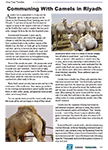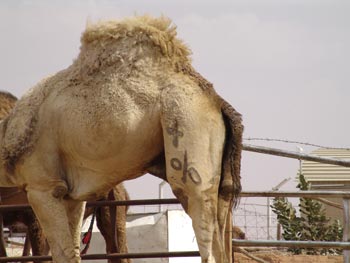Communing With Camels in Riyadh |
 |
<<Click to see original |
A soukh that is guaranteed to bring out the ‘aaaahh’ factor in almost anyone can be found on the Dammam Road, heading east out of Riyadh. A vast area of around five kilometres square is home to the largest collection of camels in the Middle East and is a market that has probably changed little in the last few hundred years.

Domesticated thousands of years ago by frankincense traders, who trained the gangly cud-chewer to make the long and arduous journey from southern Arabia to the northern regions of the Middle East, Ata Allah, or ‘God's gift’ as the Bedouin call them, went on to become the desert dweller's primary source of transport, shade, milk, meat, wool and hides. But, of course, in modern Saudi Arabia, camels are now valued more as thoroughbred racing animals than as the mainstay of transportation.
Some of the camels are eaten – the young male camel is preferred – a tough meat, but which is quite tasty, and it needs to be well marinated. Camel's milk is highly nutritious, though an acquired taste for the Western palate. Most Saudi camels are females reared for their milk in dairy herds, whilst the males that are not up to racing standard are culled ready for the pot.
Many Saudi camels are also kept as pets and live in the enclosures of this soukh area. Their owners go out there in the evenings and weekends to spend ‘quality’ time with them, to drink coffee, gossip, and generally hang out with other camel-loving friends.
You can wander freely around the camel soukh, where the locals will be only too happy to show off their prized possessions which come in a variety of colours ranging from off-white to nearly black. Look for the branding marks, or ‘wusum’, often applied to a camel’s neck, leg or rump, which shows ownership or tribal affiliation of an animal. These marks cannot be easily eradicated from the camel’s body. Each clan uses the same tribal symbol as its main identity mark, whilst minor additions to this wusum show individual ownership. These additional signs are known as Sha’ahid.

Camels have a double row of long curly eyelashes that help keep out sand and dust. Their thick bushy eyebrows shield their eyes from the desert sun; and when the camel places its foot on the ground its broad, flat, leathery pads with two toes on each foot prevent it from sinking into the sand. When walking, the camel moves both feet on one side of its body, then both feet on the other, suggesting the rolling motion of a boat, explaining the camel's 'ship of the desert' nickname.
Camels have the reputation of being bad-tempered and obstinate creatures, whereas in reality, they tend to be good-tempered, patient and intelligent. Their hearing is acute – even if they choose to pay no attention when given a command. The normal life span of a camel is 40 years, although a working camel retires from active duty at 25.
To reach Riyadh’s camel soukh, take the eastern ring road northbound, or the northern ring road eastbound to junction 8, and continue along the Dammam Road for approximately 10 kms, whence you will see endless camel enclosures on your left. Come off at the next exit, following signs for Thumamah, and you will see plenty of places to stop and park.
